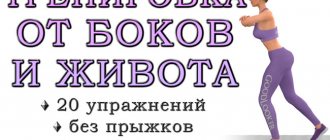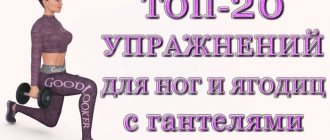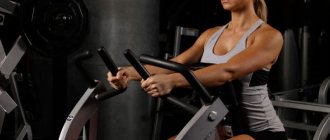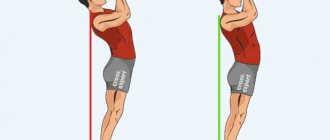How to remove a hanging belly? What exercise will help make your abs more prominent? Answered by a CrossFit athlete.
Often, when trying to achieve a beautiful body with spectacular sculpted abs, we encounter difficulties. The muscles are growing, but the abs are still not visible. This is due to the large amount of subcutaneous fat that accumulates on the abdomen. You can easily get rid of it with one exercise.
Andrey Moskvin
crossfit athlete
Vacuum is a very effective exercise for the abdominal muscles. It is good to do it in the morning and on an empty stomach. Don't overdo it: for beginners, 3-5 minutes of practice will be enough, later this time can be gradually increased.
Interesting facts about exercise
“Vacuum” comes from yoga: there it is known as “uddiyana bandha”, or “abdominal lock”. Initially, the exercise was created in order to eliminate problems with the gastrointestinal tract. Then it was noticed that the “vacuum” greatly pumps the transverse abdominal muscle, creating a kind of muscle corset and allowing you to achieve a beautiful relief and thin waist. The exercise gained particular popularity thanks to Arnold Schwarzenegger’s book “The New Encyclopedia of Bodybuilding.” Nowadays the “vacuum” technique is used in fitness, Pilates and other areas of physical activity. It is the pumping of the transverse muscle that allows you to strengthen the peritoneum and spine, has a beneficial effect on the female reproductive system and can even facilitate the process of childbirth (of course, if the expectant mother played sports before pregnancy). And the “vacuum” exercise for the abdomen can help get rid of excessive volumes: after all, this is the area that often remains problematic even in thin people.
How is a vacuum useful?
Training the transverse abdominal muscles is useful not only from an aesthetic point of view. A vacuum will help improve physical health and put the body in order.
Anastasia:
The transverse abdominis muscle belongs to the internal block along with the pelvic floor muscles, the diaphragm and the multifidus muscles of the back. And therefore, if it is not functional, this can provoke asynchronous ineffective work of all the above muscles and, as a result, cause back pain, poor posture, problems with the gastrointestinal tract and genitourinary system.
Photo: unsplash.com/@justdushawn
Regular vacuum performance:
- tightens the stomach;
- improves the functioning of the gastrointestinal tract;
- relieves tension from the lower back;
- prevents problems of the genitourinary system;
- improves blood circulation in the abdominal cavity and the functioning of all internal organs;
- prevents stagnation in the body.
Positive effect on the body
“Vacuum” would not have become so popular if it did not have a number of advantages. Among them:
- removing excessive stress from the lower back;
- improved blood circulation;
- fight against stagnation.
Regular exercise can help remove a bulging belly, make muscles more toned and reduce gastrointestinal problems. At the same time, the “vacuum” does not require any additional preparations, and it can be done lying down, standing or sitting. At an advanced level, you can perform this popular yoga asana even at work or in transport. So the exercise can be considered an ideal solution for those who want to achieve quick results and at the same time do not want to spend a lot of time doing tedious approaches and repetitions on machines in the gym.
Recommendations for Beginners
- Helpful tips for beginners:
- Refrain from breathing during the exercise. Inhalation should be done only when you release all the locks.
- The first breath after holding your breath should be light. If you take a quick, “greedy” breath, it means your breath has been held for too long. This is of no benefit to the body.
- Give sufficient time to Uddiyana Bandha and Agnisara Kriya. Proceed with the main technique only after you have completely mastered the preparatory stages.
- It is recommended to perform internal massage of the abdominal organs with an experienced mentor.
- Nauli can be performed not only while standing. Siddhasana or Siddha-yoni-asana are suitable for this. But you should understand that this is a more complex version of the practice. Performing waves becomes very difficult in this position, so it is only suitable for advanced yogis.
Who is it suitable for?
The “vacuum” exercise can be performed by women and men who want to strengthen their abdominal muscles and restore health to their internal organs. The asana is suitable even for children, but you should proceed with caution and be sure to consult a specialist before allowing your child to perform this exercise. The optimal age to start practicing “vacuum” is 16–18 years old, when the internal organs have long been formed and are sufficiently strong. In addition, the exercise is suitable for those who want to lose excess weight faster. In this case, it will have to be combined with aerobic and anaerobic exercise: the “vacuum” will strengthen the abs, but will not help you lose a few kilograms. Thus, the “vacuum” can be included in the set of exercises necessary for rapid weight loss. Or resort to it after losing weight to create a beautiful figure: a personal trainer will help you choose the ideal program.
Variations
Nauli consists of several stages. 1. Three stages of preparation:
- Madhyama Nauli - at this stage it is necessary to tense the abdominal muscles, while at the same time pushing them forward.
- Vama Nauli - the abdominal muscles move to the left.
- Dakshina Nauli - muscles move to the right.
2. The main stage or Circular Nauli: The essence of this stage of practice comes down to alternately performing Vama Nauli, and then Dakshina Nauli, as if “churning the stomach.”
Who should not perform a “vacuum”?
All asanas have contraindications, and “uddiyana bandha” was no exception. This exercise should not be done if you have:
- gastritis or duodenal ulcer;
- cholecystitis in the acute stage or pancreatitis;
- diseases of the biliary tract;
- colitis;
- dysbacteriosis;
- heart failure;
- chronic diseases of the abdominal and pelvic areas;
- menstruation;
- pregnancy;
- rehabilitation period after surgery in the abdomen or pelvis.
It is important! No exercise should be performed on a full stomach: at least an hour and a half should pass since the last meal!
If you have any disease not listed in the list of contraindications, we recommend that you first consult with your doctor in order to prevent possible negative consequences of using the vacuum technique. This is especially true for women with disorders of the genitourinary system.
How to lose weight faster?
If you have planned a full-fledged weight loss program in which you want to use a “vacuum”, it is best to start preparing in advance. Firstly, for all its effectiveness, this exercise is not able to completely get rid of fat deposits in the waist area. Secondly, it effectively works the abdominals, and not all muscles, so for quick results you will need:
- maintain water-salt balance. You need to drink at least one and a half liters of clean water per day;
- monitor your diet. Avoid fast food, store-bought sweets, carbonated drinks and juices. Eat fresh vegetables, dairy products, and protein daily. If you don't eat meat or don't eat enough of it, Herbalife Nutrition's Formula 1 shake can help replenish your protein reserves;
- to refuse from bad habits. Alcohol and cigarettes are the worst enemy of health and a beautiful figure.
Exercise technique for beginners
How to make a “vacuum” without harm to health? Start with the basics. A simple technique has been developed for beginners. You need to do the exercise while lying down. To do this, we recommend purchasing a gymnastics mat.
- Lie on your back, straighten your back and shoulders, press your lower back firmly to the floor, keep your arms along your body.
- Bend your knees slightly, placing your feet on the floor.
- Inhale slowly and deeply through your nose.
- Start exhaling through your mouth, trying to completely get rid of the air in your lungs.
- Tighten your abdominal muscles and pull it inward, as if wrapping it under your ribs.
- Stay in this position for 10–15 seconds.
- Begin to slowly relax and inhale smoothly.
- Take a few deep breaths and exhales, then repeat the exercise several times.
Gradually you will be able to hold your breath for a longer period of time. The optimal time to complete one approach is a minute.
All about abdominal vacuum and nauli: what are the benefits and video on how to do it correctly
If you have never heard of a vacuum, then you don’t have an Instagram page. The exercise “for a flat stomach” was demonstrated by, it seems, all more or less fit influencers. But there are nuances in performing seemingly simple movements. The editors of BeautyHack.ru asked various specialists all the questions that had arisen and recorded detailed video instructions: where to start and how to eventually achieve masterful use of nauli.
The main thing why bloggers love the belly vacuum is that it removes the protruding belly. But coach Anna Balobanova warns:
Anna Balobanova
Personal trainer at Elastic boutique studio
— Before removing a protruding belly, you need to figure out why it is protruding. This may occur due to prolapse of internal organs, uncoordinated muscle function, the presence of a layer of fatty tissue, and, ultimately, incorrect posture. Therefore, to say that a vacuum will help make your stomach flat is simply illiterate. But it can be one of the tools to achieve the goal. This exercise helps to better control the abdominal muscles and improves intestinal motility. And in combination with correctly and individually selected nutrition and training, with a healthy gastrointestinal tract - yes, there will be an effect. But with all the reservations.
At the same time, it is worth understanding that the vacuum of the abdomen does not pump the muscles: it is work through breathing. In simple terms, the task is to tighten the lower diaphragm; this is an internal job. The diaphragm contracts, the stomach retracts, but this does not burn the fat and does not strain the muscle. But you will learn to feel and control it, which will help in the exercises. One vacuum will definitely not remove the stomach.
EncoreFitness trainer Vadim Guryev adds: the effectiveness of the “vacuum” directly depends on how a person performs it.
Vadim Guryev
elite trainer Encore Fitness
The spine should be as close as possible to a neutral position - a round back or excessive arching will only harm the body by disrupting breathing mechanisms, squeezing blood vessels and disrupting the blood supply to the pelvic organs. When performed correctly, “vacuum” is a necessary and useful exercise that makes it possible to stabilize the lumbar region during strength exercises; it has a good effect on the pelvic floor muscles.
The benefits of abdominal vacuum and whether everyone needs to be able to do Nauli
Now let's figure out how to do a stomach vacuum correctly. Since the practice originally came out of yoga, we asked to talk about the original meaning and show the technique of performing the teacher of Jivamukti Yoga and the founder of the yoga studio “Material” Anna Lunegova. Nauli is a skill for advanced people. It’s better to start with two yogic techniques - Uddiyana Badha and Agnisara Kriya.
Anna Lunegova
Jivamukti yoga teacher and founder of the yoga studio “Material”
— Nauli is the most important of the practices of Hatha Yoga. It involves circular manipulation of the abdominal muscles, creating a dynamic massage of the internal organs (small and large intestines). This practice improves the functioning of the liver, pelvic organs, and improves blood circulation. It also makes breathing deep and smooth and, therefore, affects the functioning of the brain.
Nauli is an intense practice and requires levels of training. It’s better to start with two yogic techniques - Uddiyana Bandha and Agnisara Dhauti Kriya
Contraindications
Nauli, Uddiyana Badha and Agnisara Kriya have contraindications: the female cycle and several days before and after it, exacerbation of diseases associated with the digestive system, high blood pressure, umbilical hernia.
When to do it
It is better to perform these techniques in the morning on an empty stomach, after drinking a glass of warm water. If desired, they can be done during the day, but not on a full stomach (at least 2-3 hours should pass after eating).
Important!
If you feel discomfort while doing it, but there are no contraindications listed above, continue the practice. This may indicate stagnant processes in the digestive organs, which are eliminated thanks to the proposed techniques.
Now we will analyze each of the practices separately - from simple to complex.
Uddiyana Badha
Preparation for practice
Stand up straight, place your feet hip-width apart or slightly wider. Place the fingers of one hand between your collarbones.
Take a deep breath, hold your breath, lifting your chest up to form the supraclavicular fossa (then your stomach naturally pulls in and up). Remember the position of your stomach, it will be useful in this and future practices.
Release the delay.
Doing the practice
Stand up straight, place your feet hip-width apart or slightly wider.
Take a deep breath, bend down, place your palms just above your knees and exhale twice so that all the air comes out. While holding the hold after exhaling, straighten your elbows, keep your back straight, and point your chin towards your collarbones. Take a false breath, pulling your stomach in and up. This is Uddiyana Bandha.
Remain in the delay until the first urge to take a breath (gradually the time spent in the delay will increase).
Before you inhale, release your stomach, exhale, and as you inhale, straighten up.
Restore your breathing.
Important!
Do not overextend the hold after exhalation. After it, you should inhale easily, and then breathe evenly.
Agnisara Dhauti Kriya
Doing the practice
Repeat the previous technique you mastered. Remaining in a hold after exhaling, release your stomach down, and then pull it in and up again. Do this several times until you feel the urge to inhale. Then release your stomach, exhale and, as you inhale, rise up. Restore your breathing and repeat the practice a few more times.
Additional variation for hand position: place them closer to the hip joints.
Important!
Don't rush into the frequency of your belly movements. First you should set the amplitude, and then do it as many times as you can. Count how many times you release and retract your stomach. Letting go and pulling in the belly is one circle. Starting from five circles, try to bring them to a hundred. Progress will be noticeable with each practice - you will hold your breath longer and the number of circles will increase.
Nauli Kriya
Preparation for practice
Lie on your back, lift your head up, leaving your shoulders on the floor. Take a deep breath and exhale, then hold your breath. Pull your stomach in, but push your rectus abdominis muscles out (watch our video carefully).
Release your stomach and hold your breath, breathe naturally.
Performing the practice of Madhyama Nauli (middle tourniquet)
Stand up straight, place your feet hip-width apart or slightly wider.
Take a deep breath, bend down, place your palms just above your knees and exhale twice so that all the air comes out. Remaining in the hold after exhaling, straighten your elbows, keep your back straight, and point your chin towards your collarbones. Take a false breath, pulling your stomach in and up and pushing your rectus abdominis muscles out (as in preparation for practice).
Mastering the technique: move the tourniquet to the right side (Dakshina Nauli - release of the right rectus abdominis muscle), you can step your right foot forward and shift the weight to the right side. Then return the tourniquet to the center, returning the leg to its original position. Move the tourniquet to the left side (Vama Nauli), you can step forward with your left foot, shifting your weight to the left side.
Full version of Nauli Kriya (circular rotation of the tourniquet)
The technique begins with the development of the central cord, and then its displacement to the right, inward, left and outward - this is one circle. The nature of the movement is smooth, continuous. As with previous techniques, first set the range of motion and then the speed. Move the tourniquet first clockwise (be sure to count the number of circles), and then counterclockwise (there should be the same number of circles). Circles clockwise and counterclockwise can be done in one hold after exhalation or divided into different breath holds.
Release your stomach, exhale a little, and inhale as you rise up.
Restore your breathing and repeat the practice again.
Important!
Count the number of circles (waves) you do in one hold after exhaling. You can start with 5 or 10 circles. The main thing is to repeat the practice regularly and track your progress. There are no boundaries for perfection. Ideally, you should achieve 200 circles (or waves) on one breath hold (or 100 times in one direction and 100 times in the other).
Will you try it?
Video and editing: Anton Polyakov
Text: Natalya Pikus, Kristina Semina
We thank the yoga studio “Material” for their assistance in filming.
Exercise technique for intermediate level
Three to four months after the start of training, it will be possible to complicate the asana. To do this, there is a technique for performing the exercise on all fours.
- Get on your knees and place your straight arms on the floor.
- Your thighs should be perpendicular to your shins.
- Release all the air from your lungs and draw in your stomach while arching your back.
- Hold the position for 30 seconds.
- Relax, take a few deep breaths.
You can repeat the exercise for 3-4 approaches.
The second method is suitable for regular use, even at the workplace or in transport.
- Sit down, place your feet on the floor, straighten your back.
- Release all the air from your lungs and draw in your stomach.
- Exhale, relax, do 3-5 repetitions.
Try not to stay in the “vacuum” state for more than a minute: this will not be of much benefit.
What it is?
Nauli is one of the shatkarmas, six practices that purify the body and spirit of the yogi, given to us by the ancient sages. Their actions are aimed at getting rid of impurities from the practitioner’s body and hygiene of the mind. These techniques allow you to discover new facets and depths during internal practices.
The author of the world famous book “Hatha Yoga Pradipika” Swatmarama recognized Nauli as the main cleansing technique of Hatha Yoga. Our ancestors also noticed that the state of the organs of the digestive system clearly affects the health of the entire body.
In addition to the beneficial effect on the body, the technique has earned popularity because it does not require special equipment. All you need is your own body and the desire to practice.
Exercise technique for advanced level
How to do a “vacuum” correctly for those who have been performing this asana for several months? You can move on to the most difficult type of exercise: standing. Here you will have to use your own capabilities, and not rely on gravity.
- Stand up straight, keep your back straight, feet shoulder-width apart, arms along your body.
- Inhale deeply and exhale slowly, clearing the air from your lungs.
- Stay in this position for as long as possible, and then begin to breathe slowly.
It is important! For the greatest effectiveness, abdominal exercises are recommended to be done not only in the morning or evening, but throughout the day. You can train anywhere: sitting at work, lying on the couch at home or standing on the street. As a result, this will become a habit, and the transverse muscle will become well-developed and strong.**
Which is better: vacuum or regular abdominal exercises?
To perform the exercise effectively, you must learn to draw in your stomach, using the internal muscles. The transverse abdominis muscle is located under the internal oblique muscle, so it is not easy to reach.
When performing classic abdominal exercises, such as lying crunches, the transverse muscle is not involved in the work. With your hands on your knees or the floor, you “turn off” your abs and reach the transverse muscle.
Scientific approach: how to pump up your abs according to Harvard's recommendations
Both on vacation and at home: 5 effective abdominal exercises
The question arises, is it possible to replace abdominal exercises with a vacuum? It cannot be replaced, but you can do both in combination to achieve better results in a shorter time.











